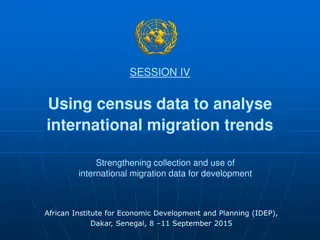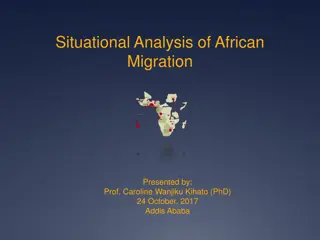Evaluating, Planning, and Completing a Migration: A Case Study by Elizabeth Chance
Elizabeth Chance, an MLIS Digital Curation Librarian at Fort Hays State University, discusses the background, rationale, and outcomes of successfully migrating digital collections. She shares insights gained from the migration process, focusing on challenges, solutions, and lessons learned.
Download Presentation

Please find below an Image/Link to download the presentation.
The content on the website is provided AS IS for your information and personal use only. It may not be sold, licensed, or shared on other websites without obtaining consent from the author.If you encounter any issues during the download, it is possible that the publisher has removed the file from their server.
You are allowed to download the files provided on this website for personal or commercial use, subject to the condition that they are used lawfully. All files are the property of their respective owners.
The content on the website is provided AS IS for your information and personal use only. It may not be sold, licensed, or shared on other websites without obtaining consent from the author.
E N D
Presentation Transcript
Evaluating, Planning, and Completing a Successful Migration: A Case Study Elizabeth Chance, MLIS Digital Curation Librarian Forsyth Library Fort Hays State University
What Im going to talk about today: Background information Rationale for migrating collections Collections we ve moved Results of moving those collections What we learned from the migration process
My background Digital curation librarian Hold responsibility for all digital collections that are not e-resources Digitized collections from archives, special collections, and faculty publications This includes the nuts and bolts of running our repository My background is in CONTENTdm Worked with CONTENTdm for 5+ years Metadata cataloger before coming to FHSU Had no previous experience with Digital Commons Had never heard of an IR Completely new to academia
Background: Forsyth Digital Collections Digital collections going back to 2004 Acquired CONTENTdm in 2008 Cost shared with other departments who use the platform This cost-sharing means that the library will continue to maintain collections in CONTENTdm CONTENTdm was limited in what it could do FHSU has a history of publishing journals in education and leadership and CONTENTdm wasn t very good for presenting those journals ETDs in CONTENTdm were hard to search No good options for faculty scholarly works FHSU Scholars Repository went live in January 2016 Developed specifically as an institutional repository and journal platform
Rationale: Where to even start? CONTENTdm Does well with image galleries Allows for in-depth description of complex items like scrapbooks Has native streaming abilities for audio and video Can easily present a variety of file formats in a single collection Has a hard time with large .pdf files Difficult to embed third-party content Needs detailed metadata which is great for research collections Digital Commons Great for text-based items Requires less metadata to get the discovery job done Better integration for OCR and in-text searching File formats other than .pdf require extra steps Can easily embed third-party content like book readers and YouTube videos No mechanism for handling compound objects like front and back of a photograph or items in a scrapbook Less metadata isn t so great for research collections but makes showcase collections more feasible
Rationale: What goes where? Access Text-based collections Would benefit from expanded text-search capabilities and better integration of OCR Scholarly works Would benefit from inclusion in the Digital Commons network User experience .pdf-based collections Looking for better load times Desire to enhance the user experience through the presence of a book reader that allows patrons to flip through a book
What did we move? Journals Academic Leadership: The Online Journal Journal of Business & Leadership Archival Collections Reveille Yearbooks Athletics Programs Graduate Student Works Master of Liberal Studies Research Papers Masters Theses Collection (In Progress)
What did we move? Journals Academic Leadership: The Online Journal Journal of Business & Leadership Archival Collections Reveille Yearbooks Athletics Programs Graduate Student Works Master of Liberal Studies Research Papers Masters Theses Collection (In Progress) Scholarly Works
What did we move? Journals Academic Leadership: The Online Journal Journal of Business & Leadership Archival Collections Reveille Yearbooks Athletics Programs Graduate Student Works Master of Liberal Studies Research Papers Masters Theses Collection (In Progress) Scholarly Works Not Scholarly Works So what are they?
Research Collections vs. Showcase Collections Showcase Collections Highlight the history of the University Research Collections Support the academic mission of the University Connect users with unique collections Provide access to faculty research and projects Share the story of our campus community with the world Advance the scholarly conversation They re fun! Provide access to primary source materials for researchers
The Reveille: Background Official Yearbook of Fort Hays State University Published from 1914-2003 Initially Digitized in 2009 Three distinct versions of the digital collection Reveille 1.0, 2.0 and 3.0 Important to alumni and library leadership The collection suffered from a variety of problems from the start and subsequent efforts to improve the collection didn t do much to make it better
Reveille 1.0: 2009-2014 Originally photographed rather than scanned Images were converted to .pdf but couldn t be effectively OCR ed Quality of the images wasn t very good Text searching was limited to transcripted information The year books were online but unless you knew exactly who and when you were looking for, your options were limited The collection was being used, but not to the extent desired Usage data is spotty and unreliable but what data we do have suggests the collection was getting about 3 interactions per item per month during this period
Reveille 2.0: 2014-2017 In the spring of 2014 the decision was made to revisit the Reveille collection Determined that the issue with the collection was image quality Wanted images that were higher quality, nicer to look at, and text searchable Decided to remaster the entire collection by scanning rather than photographing New files were much larger than Reveille 1.0 Organized into huge .pdfs Reveille 1.0 was taken down and 2.0 went up The .pdfs themselves were text-searchable but they never integrated the OCR into CONTENTdm Organized the objects in CONTENTdm as compound objects rather than single objects in an attempt to get them to load faster Never completed metadata for pages within the parent items
Reveille 3.0 Reveille 2.0 was less usable than Reveille 1.0 Usage per item fell from 3 interactions per month down to 1.75 Two choices going forward Fix Reveille 2.0 Go for a Reveille 3.0 Fixing Reveille 2.0 Reveille 3.0 Create a new collection in Digital Commons Pdfs were too large for CONTENTdm 300+ pages in some cases Use the pdfs created for Reveille 2.0 Re-upload the items to CONTENTdm as a traditional image-based compound object Take advantage of Digital Commons text search capabilities to reduce the need for metadata creation Create metadata for all pages within the compound object Transcribe name data to make the collection text searchable
Designing Reveille 3.0 Definite ideas about what the collection should look like Wanted a browsing collection Wanted to highlight the covers of the yearbooks Wanted to be able to flip through an issue like you would if you had visited the archives Wanted the collection to be text-searchable Digital Commons has a variety of structure types, not all of which do the same things. Book gallery was chosen for its ability to do thumbnail browsing Had to decide on a third party book reader to embed
Reveille 3.0 Moving the Files Used Bepress batch upload process pdfs were reduced in size to get them under 100mb This allowed us to use the first page as the cover image Re-ran OCR on all the files Uploaded files to our library upload server using Filezilla Created new metadata where necessary and cleaned up old metadata where possible Uploaded individual volumes to the Internet Archive along with the accompanying metadata so we could embed the book reader Took the opportunity to inventory all of the master scans so they could be accessioned into our formal preservation system Standardized file names
Reveille 3.0 Hows She Doing? Went live in July 2017 As of May 1, 2018 1,689 downloads 3,525 metadata page hits Notes about comparing usage CONTENTdm tracks page views Digital Commons tracks downloads and metadata page hits Chose metadata page hits as our preferred metric to reflect the fact that most users will view the item using the book reader and not download the full issue 3.96 interactions per item per month Reveille 1.0 = 3 interactions per item per month Reveille 2.0 = 1.75 interactions per item per month
What we learned Determine first why your collection isn t performing the way you expect it to Preserve historical usage data Document your process What did you do and why? Find a way to address problems with the resources available How much time and effort do you have to spare? Ask for help! Looking at other collections from similar institutions was a key activity Talking to other librarians who had faced the same issues was also key Get out of the CONTENTdm box CONTENTdm was designed around libraries and catalogers and so you think like a cataloger when you use it Digital Commons works more like a web discovery system so you don t need all of that metadata to make it work
THANK YOU! Elizabeth Chance Digital Curation Librarian Fort Hays State University mechance2@fhsu.edu























